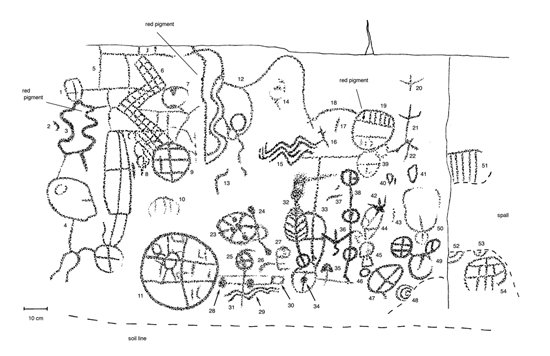How we do what we do
Through behavior, cognition, and sensory perceptions, indigenous people assigned meaning to the environment and transformed spaces into places. Geoglyphs, rock alignments, cairn complexes, and rock art are just a few of the features that give evidence of those who have gone before. These features and places have meaning and are not just separate manifestations of a prehistoric society but functioned within the framework of a cultural landscape.
Western Rock Art Research endeavors to assist in defining the cultural landscape. The emphasis of the research is to continue to document sensitive archaeological and rock art sites to provide baseline monitoring information and inform management decisions.
METHODS
Our company has earned a reputation for non-impact visitation, and non-invasive, non-destructive recordation. We are dedicated to the preservation, documentation, and research of Indigenous and early historic rock art in the American West and throughout the world. Founded in 2006, the purpose of WRAR is to promote and facilitate the preservation and scientific research of prehistoric and historic rock art heritage resources. This mission is accomplished by:
Initiating an active inventory program to identify endangered, at risk resources followed by thorough resource documentation to current standards;
Significance evaluation;
Resource management planning to meet the needs of private, state and federal land managers;
Establishing and maintaining a permanent digital and electronic archival record to be shared with appropriate land managers and recognized repositories or academic institutions;
Consulting with appropriate Native American and Aboriginal groups to incorporate their perspectives and concerns;
Engaging the services of specialists and other professionals as deemed necessary;
And cooperatively working with fellow researchers, organizations, and institutions to promote the distribution of rock art research and encourage and support public education to broaden our common knowledge, understanding, and appreciation of rock art.
This research provides information that can directly inform management offices in developing appropriate management strategies for the identified sites by providing:
Spatially explicit (GIS) data for rock art locations, areas of highest density for cultural remains;
Updated Department of Parks and Recreation Site Record (or other state- or entity-specific forms);
Condition Assessment for each site, with baseline conditions and impact agents identified; and
High-resolution digital format imagery (JPEG format) of all features and artifacts including all rock art; a photo log documenting each photo;
Scaled drawings of all discernible rock art panels, motifs within panels, and all associated artifacts and rock features.
With complete recordation and assessment of prehistoric sites within the area, eligibility for the National Register of Historic Places (NRHP) can also be determined.
More specifically, Recordation methods specifically include:
Using DStretch software with all photography, specially designed for applying filters for rock art visibility;
Current identifications and statistics of lithic projectile point and debitage material;
Current identifications and statistics of groundstone material.
State-of-the-art GIS capabilities to determine and illustrate locational information, acreage of area surveyed, and areas of highest artifact and rock art density
Extreme care is taken to ensure both the safety of team members and the protection and conservation of the natural and cultural values occurring at the site.
All WRAR members are active in education and providing public lectures in efforts to promote respect and stewardship for our environmental and cultural history.
As part of this outreach, WRAR distributes easy step-by-step documentation procedures for any interested site-steward.
Don Christensen photographing and measuring rock art panels in Utah. Photo credit: David Lee





